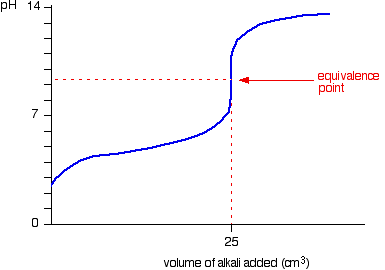Question #006d1
1 Answer
Here's what I got.
Explanation:
!! LONG ANSWER !!
The first thing that you need to do here is to figure out the concentration of the hydrocyanic acid.
You know that hydrocyanic acid and sodium hydroxide neutralize each other in a
#"HCN"_ ((aq)) + "NaOH"_ ((aq)) -> "H"_ 2"O"_ ((l)) + "NaCN"_ ((aq))#
This means that in order to get to the equivalence point, you need to mix equal numbers of moles of hydrocyanic acid and of sodium hydroxide.
Use the molarity and the volume of the sodium hydroxide solution to find the number of moles required to neutralize all the moles of hydrocyanic acid present in the sample.
#45 color(red)(cancel(color(black)("mL"))) * "0.2 moles NaOH"/(10^3color(red)(cancel(color(black)("mL")))) = "0.0090 moles NaOH"#
This means that the hydrocyanic acid solution contained
#["HCN"] = "0.0090 moles"/(100 * 10^(-3) quad "L") = color(darkgreen)(ul(color(black)("0.090 M")))#
I'll leave it rounded to two sig figs, but don't forget that you have one significant figure for the volume of the hydrocyanic acid solution and for the molarity of the sodium hydroxide solution.
Now, notice that the reaction produces sodium cyanide in
The total volume of the resulting solution will be
#V_"sol" = "45 mL" + "100 mL"#
#V_"sol" = "145 mL"#
This means that the molarity of the sodium cyanide will be
#["NaCN"] = "0.0090 moles"/(145 * 10^(-3) quad "L") = "0.0621 M"#
Since sodium cyanide is soluble in aqueous solution, it will exist as sodium cations and cyanide anions in the resulting solution.
#["CN"^(-)] = ["NaCN"] = "0.0621 M"#
Now, the cyanide anion will act as a weak base and react with water to reform some of the weak acid and produce hydroxide anions,
#"CN"_ ((aq))^(-) + "H"_ 2"O"_ ((l)) rightleftharpoons "HCN"_ ((aq)) + "OH"_ ((aq))^(-)#
Right from the start, this tells you that the
By definition, the base dissociation constant for the cyanide anion,
#K_b = (["HCN"] * ["OH"^(-)])/(["CN"^(-)])#
If you take
#["HCN"] = ["OH"^(-)] = x quad "M"#
and
#["CN"^(-)] = (0.0621 - x) quad "M"# This means that in order for the weak base to produce
#x# #"M"# of hydrocyanic acid and#x# #"M"# of hydroxide anions, its concentration must decrease by#x# #"M"# .
Plug this into the expression of the base dissociation constant to get
#K_b = (x * x)/(0.0621 - x)#
#1.6 * 10^(-5) = x^2/(0.0621 - x)#
The base dissociation constant for the cyanide anion can be found here.
Since the value of the base dissociation constant is so small compared to the initial concentration of the cyanide anions, you can sue the approximation
#0.0621 - x ~~ 0.0621#
This means that you have
#1.6 * 10^(-5) = x^2/0.0621#
which will get you
#x = sqrt((0.0621 * 1.6 * 10^(-5)) = 9.97 * 10^(-4)#
Since
#["OH"^(-)] = 9.97 * 10^(-4)#
You can thus say that the
#"pH" = 14 - [-log(["OH"^(-)])]#
#"pH" = 14 + log(9.97 * 10^(-4)#
#color(darkgreen)(ul(color(black)("pH" = 11.0)))#
The answer is rounded to one decimal place.
As predicted, the


